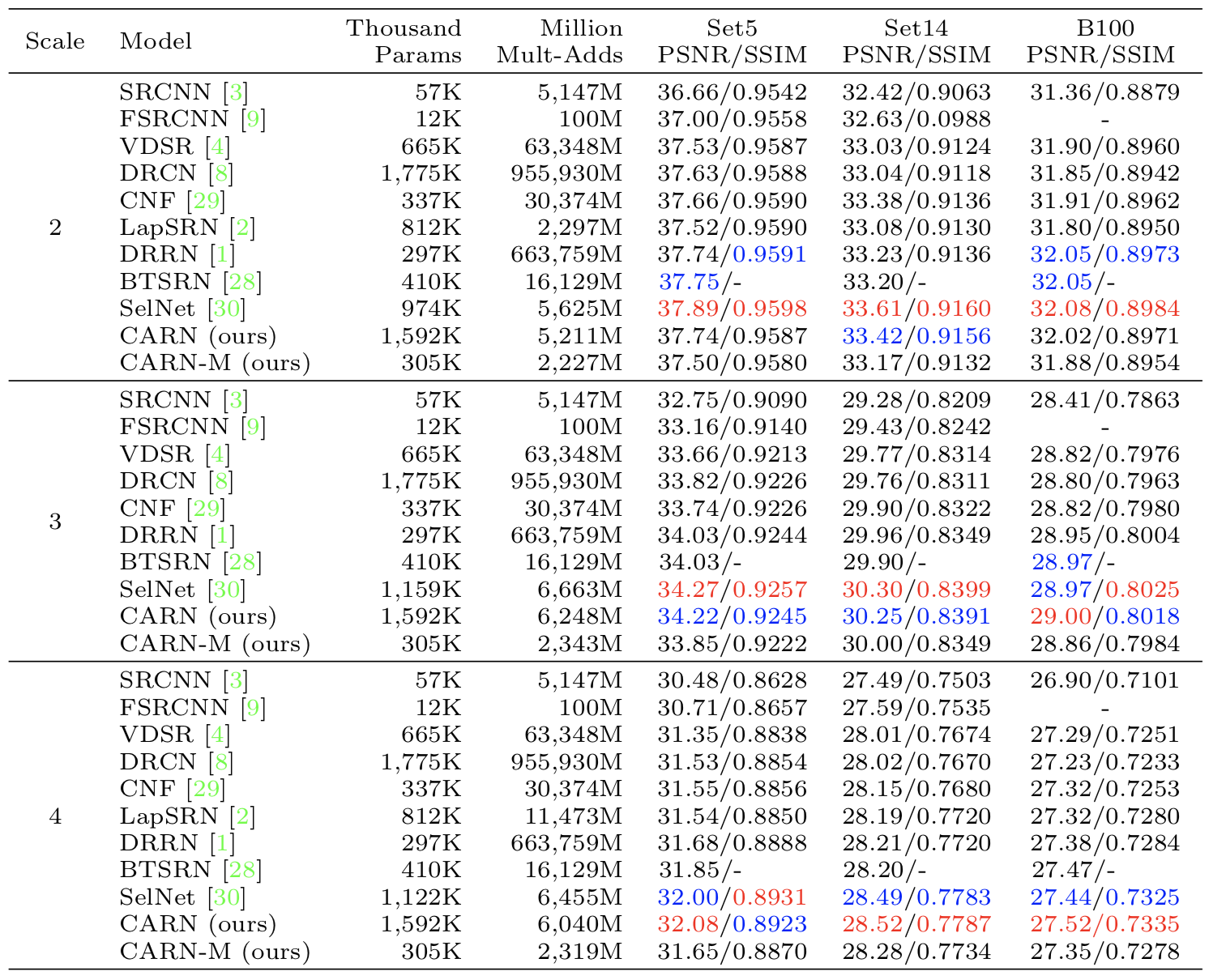Namhyuk Ahn, Byungkon Kang, Kyung-Ah Sohn [arXiv]
In recent years, deep learning methods have been successfully applied to single-image super-resolution tasks. Despite their great performances, deep learning methods cannot be easily applied to real-world applications due to the requirement of heavy computation. In this paper, we address this issue by proposing an accurate and lightweight deep learning model for image super-resolution. In detail, we design an architecture that implements a cascading mechanism upon a residual network. We also present a variant model of the proposed cascading residual network to further improve efficiency. Our extensive experiments show that even with much fewer parameters and operations, our models achieve performance comparable to that of state-of-the-art methods.
- Python 3
- PyTorch (0.3.0), torchvision
- Numpy, Scipy
- Pillow, Scikit-image
- h5py
- importlib
We use DIV2K dataset for training and Set5, Set14, B100 and Urban100 dataset for the benchmark test. Here are the following steps to prepare datasets.
- Download DIV2K and unzip on
datasetdirectory as below:
dataset
└── DIV2K
├── DIV2K_train_HR
├── DIV2K_train_LR_bicubic
├── DIV2K_valid_HR
└── DIV2K_valid_LR_bicubic
- To accelerate training, we first convert training images to h5 format as follow (h5py module has to be installed).
$ cd datasets && python div2h5.py- Other benchmark datasets can be downloaded in here. Same as DIV2K, please put all the datasets in
datasetdirectory.
We provide the pretrained models in checkpoint directory. To test CARN on benchmark dataset:
$ python carn/sample.py --model carn \
--test_data_dir ... \
--scale 4 \
--ckpt_path ./checkpoint/carn.pth \
--sample_dir ./sampleand for CARN-M,
$ python carn/sample.py --model carn_m \
--test_data_dir ... \
--scale 4 \
--group 4 \
--reduce_upsample \
--ckpt_path ./checkpoint/carn_m.pth \
--sample_dir ./sample \To test on DIV2K dataset, set test_data_dir argument as dataset/DIV2K/DIV2K_valid and for other dataset, it should be dataset/other_dataset_dir.
Or, we provide our results on four benchmark dataset (Set5, Set14, B100 and Urban100) in here.
Here are our default settings to train CARN and CARN-M. Note: We only have experiments on TITAN X or 1080ti. If OOM error occurs, please decrease batch size.
# For CARN
python carn/train.py --patch_size 48 \
--batch_size 32 \
--max_steps 500000 \
--decay 300000 \
--model carn \
--ckpt_name carn \
--scale 0 \
--num_gpu 1
# For CARN-M
python carn/train.py --patch_size 48 \
--batch_size 32 \
--max_steps 500000 \
--decay 300000 \
--model carn_m \
--ckpt_name carn_m \
--group 4 \
--reduce_upsample \
--scale 0 \
--num_gpu 1In the --scale argument, [2, 3, 4] is for single-scale training and 0 for multi-scale learning. --group represents group size of group convolution inside of efficient residual block. --reduce_upsample means use 1x1 convolution instead of 3x3 in the upsampling layer.
Quantitative evaluation of state-of-the-art SR algorithms

Visual qualitative comparison on 4× scale datasets.

@article{ahn2018fast,
title={Fast, Accurate, and, Lightweight Super-Resolution with Cascading Residual Network},
author={Ahn, Namhyuk and Kang, Byungkon and Sohn, Kyung-Ah},
journal={arXiv preprint arXiv:1803.08664},
year={2018}
}